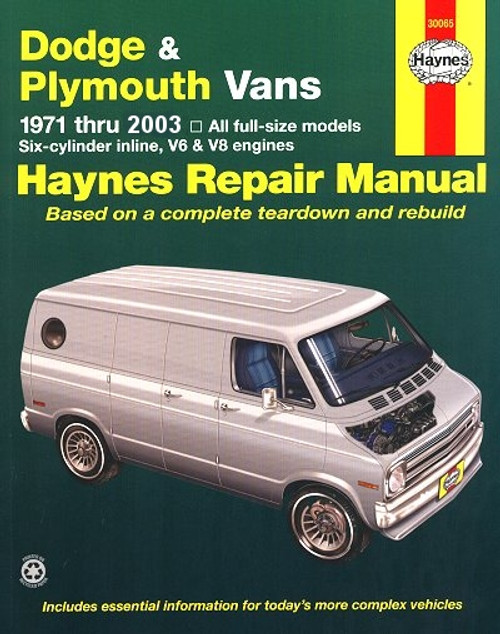The 2000-2005 Dodge Neon Plymouth Neon Repair Service Manual by Haynes, covers the following models:
Book Excerpt: 2000-2005 Dodge Neon, Plymouth Neon Repair Manual GENERAL ENGINE OVERHAUL PROCEDURES
SUSPENSION AND STEERING SYSTEMS
Subject: 2000, 2001, 2002, 2003, 2004, 2005 Dodge, Plymouth Neon service, maintenance, repair. ISBN-10: 1563925966 | ISBN-13: 9781563925962 | Haynes 30036
- Dodge Neon, 2000 to 2005
- Plymouth Neon, 2000 to 2005
Book Excerpt: 2000-2005 Dodge Neon, Plymouth Neon Repair Manual GENERAL ENGINE OVERHAUL PROCEDURES
PISTON RING INSTALLATION
(Refer to illustrations 9.13, 9.14, 9.15, 9.19a, 9.19b and 9.22)
- Before installing the new piston rings, the ring end gaps must be checked. It's assumed that the piston ring side clearance has been checked and verified correct.
- Lay out the piston/connecting rod assemblies and the new ring sets so the ring sets will be matched with the same piston and cylinder during the end gap measurement and engine assembly.
- Insert the top (number one) ring into the first cylinder and square it in with the top of the piston (see illustration). The ring should be near the bottom of the cylinder, at the lower limit of ring travel.
- To measure the end gap, slip feeler gauges between the ends of the ring until a gauge equal to the gap width is found (see illustration). The feeler gauge should slide between the ring ends with a slight amount of drag. A typical ring gap should fall between 0.010 and 0.020 inch (0.25 to 0.50 mm) for compression rings and up to 0.030 inch (0.76 mm) for the oil ring steel rails. If the gap is larger or smaller than specified, double-check to make sure you have the correct rings before proceeding.
- If the gap is too small, it must be enlarged or the ring ends may come in contact with each other during engine operation, which can cause serious damage to the engine. If necessary, increase the end gaps by filling the ring ends very carefully with a fine file. Mount the file in a vise equipped with soft jaws, slip the ring over the file with the ends contacting the file face and slowly move the ring to remove material from the ends. When performing this operation, file only by pushing the ring from the outside end of the file towards the vise (see illustration).
- Excess end gap isn't critical unless it's greater than 0.040 inch (1.01 mm). Again, double-check to make sure you have the correct ring type.
- Repeat the procedure for each ring that will be installed in the first cylinder and for each ring in the remaining cylinders. Remember to keep rings, pistons and cylinders matched up.
- Once the ring end gaps have been checked/corrected, the rings can be installed on the pistons.
- The oil control ring (lowest one on the piston) is usually installed first. It's composed of three separate components. Slip the spacer/expander into the groove (see illustration). If an anti-rotation tang is used, make sure it's inserted into the drilled hole in the ring groove. Next, install the upper side rail in the same manner (see illustration). Don't use a piston ring installation tool on the oil ring side rails, as they may be damaged. Instead, place one end of the side rail into the groove between the spacer/expander and the ring land, hold it firmly in place and slide a finger around the piston while pushing the rail into the groove. Finally, install the lower side rail.
- After the three oil ring components have been installed, check to make sure that both the upper and lower side rails can be rotated smoothly inside the ring grooves.
SUSPENSION AND STEERING SYSTEMS
STEERING KNUCKLE, HUB AND BEARING | REMOVAL, INSPECTION AND INSTALLATION REMOVAL
- With the vehicle weight resting on the front suspension, remove the hub cap, cotter pin, nut lock and spring washer. Loosen, but do not remove the front hub (driveaxle) nut and wheel lug nuts.
- Raise the front of the vehicle, support it securely on jackstands and remove the front wheels.
- Remove the caliper and brake pads (see Chapter 9). Taking care not to twist the brake hose, hang the caliper out of the way in the wheel well with a piece of wire. If the vehicle is equipped with ABS, remove the wheel speed sensor from the steering knuckle.
- Disconnect the tie-rod end from the steering knuckle (see Section 16).
Subject: 2000, 2001, 2002, 2003, 2004, 2005 Dodge, Plymouth Neon service, maintenance, repair. ISBN-10: 1563925966 | ISBN-13: 9781563925962 | Haynes 30036
TABLE of CONTENTS:
Introduction: Vehicle identification numbers. Buying parts. Safety. Maintenance techniques. Chemical and lubricants, and more.
- Tune-up and routine maintenance
- 2.0L SOHC 4-cylinder 132hp engine
- 2.0L High-Output (HO) 4-cylinder 150hp engine
- General engine overhaul procedures
- Cooling, heating and air-conditioning systems
- Fuel and exhaust systems
- Engine electrical systems
- Emissions control systems
- 5-speed manual transaxle
- 3-, 4-speed automatic transaxle
- Clutch and driveaxles
- Brakes, ABS
- Suspension and steering systems
- Body
- Chassis electrical system
- Wiring diagrams










